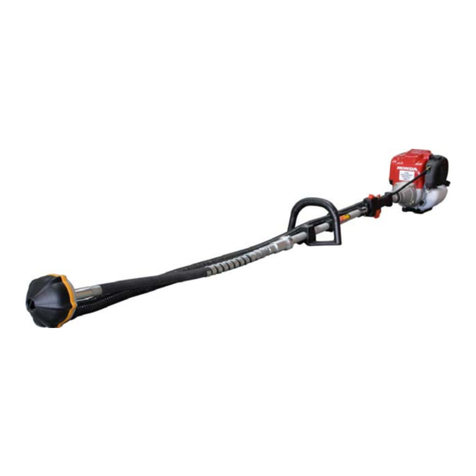
FLEXTOOL OPERATING INSTRUCTIONS FLEXTOOL SUBMERSIBLE PUMPS
3
1300 353 986 flextool.com.au
FLEXTOOL OPERATING INSTRUCTIONS SUBMERSIBLE PUMPS
3
1300 353 986 flextool.com.au
! FIRE & EXPLOSION HAZARDS
PETROL is extremely flammable and explosive under certain
conditions.
! CHEMICAL HAZARDS
CARBON MONOXIDE exhaust gases from internal combustion
motor driven units can cause death in confined spaces.
! ADDITIONAL HAZARDS
HANDLE IMPELLERS WITH CARE when the pump body is
removed. Pumps that have been subject to extensive use with
abrasive materials may have impellers that are severely worn leaving
sharp, thin or brittle sections.
USE GLOVES when handling and inspecting the flexible shaft outer
casing. Excessive wear of the rubber cover can expose the wire
braided reinforcement, allowing it to project and cause injury.
DO NOT use the pump for handling flammable liquids.
Slip/Trip/Fall is a major cause of serious injury or death.
Beware of excess hose, the flexible shaft and water left on the
walking or work surface.
DO NOT allow waste water to accumulate under foot.
EXERCISE care when working in the vicinity of unprotected holes or
excacations.
Sump pumping is the simplest method of dewatering.
Pumping from ‘open’ sumps is generally used in coarse sands and
gravels. It is difficult to control the migration of ‘fines’ and should
not be used if soil displacement is a critical factor of consideration
when working near existing structures, roads, etc.
ADDITIONAL INFORMATION
Refer to the drive unit operation instructions for additional safety
and operation information on the appropriate drive unit.
OPERATION
For information on correct starting procedures refer to the engine
manufacturers operation manual.
Do not engage the drive coupling while the motor is rotating.
Before engaging the flexshaft with a petrol drive unit start the motor
using the recoil starter, increase the speed to full throttle and allow
it to warm up for a few minutes.
Stop the motor.
Turn the bell housing trigger 180 degrees. Insert the flexshaft
coupling fully into the housing of the drive unit and release the
trigger. Push the coupling into the housing and twist the flexible
shaft until the drive dogs are fully engaged and the trigger returns to
the horizontal position.
The motor may now be started.
If the pump flexible shaft is fitted with an external movable spring,
it should be positioned to provide support where the shaft passes
over the edge of a trench or obstruction.
When pumping from deep pits or excavations avoid subjecting the
flexshaft to the total weight of the pump and the discharge hose.
Support the weight of the pump by attaching a rope to one of the
pump eye-nuts. Secure the other end of the rope to a support
adjacent to the power unit so that it takes the weight of the pump
off the flexshaft.
Drive units should be operated on a level surface. If the surface is
not level the drive unit should be restrained to ensure that it does
not move due to vibration or the weight of the pump and the hose.
Avoid extended running of the pump without water, or with the
flexible shaft in a tight curve.
Never operate the pump flexible shaft in the reverse direction, as
this will damage the flexible core. If the impeller is fouled, remove
the bearing housing and manually clear the impeller.
HOW TO GET THE BEST PERFORMANCE FROM YOUR
PUMP.
Maximum discharge performance of the pump will only be
obtained when a reinforced discharge hose is used. This minimises
kinking where the hose passes over obstructions and permits the
unobstructed passage of solids.
If there is a tendency for the pump head to bury itself in heavy
sediment, overcome this by improvising an auxiliary strainer.
Remove the top from an empty 20 litre drum and punch openings
around the sides. Place the pump head in the drum below the
water.
Improved head performance will be obtained by increasing the
governed speed of the drive unit motor. It is recommended that
a motor with a minimum output of 5.6 kW (7.5 hp) is used for
continuous running above 3,000 r/min.
PUMPING CLEAN WATER
When there is a need to pump clean water without the sludge, grit
or solids that have collected at the bottom of a stream, dam, tank
or pit, keep the pump off the bottom. This will also minimise wear
from pumping abrasive materials.
In a pit or excavation attach a rope to an eye nut on the pump and
suspend the pump from the rope.
In dams and ponds support the pump from a float made from an
empty sealed steel or plastic container or a marine buoy.
PUMPING HEAVY SLUDGE AND SOLIDS
Best results are obtained if the solids on the bottom of the pit or
pond are stirred into the surface liquid. The most effective way
of achieving this is to direct a hose from the submersible pump,
a large volume tap or a second pump, using waste water, into
the tank or pit for a short time until the solids are stirred from the
bottom.
USE A SUITABLE HOSE
Layflat hose is lightweight and rolls flat to facilitate handling and
storage, lt is less expensive than reinforced discharge hose.
However, layflat hose can kink and impede the flow of the fluid
and solids. For best results when using layflat hose, lay it flat on
the ground keeping it free from kinks, bends and twisting where
possible.
A reinforced hose of 50 mm diameter will improve the discharge
performance, while a 75 mm diameter hose will give superior
discharge performance.
QUICK ACTION HOSE FITTINGS
Cam lever-action fittings enable quick connection of hose to the
pump. They save time and eliminate problems with dirty screw
threads and missing washers that are common with nut and tail
screw thread fittings. Joiners are available for coupling separate
hoses.

























